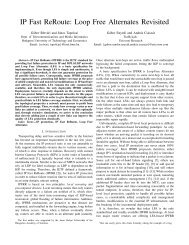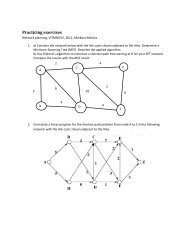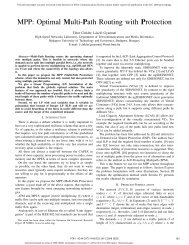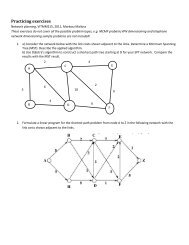NOVEL ALGORITHMS FOR IP FAST REROUTE (DRAFT)
NOVEL ALGORITHMS FOR IP FAST REROUTE (DRAFT)
NOVEL ALGORITHMS FOR IP FAST REROUTE (DRAFT)
You also want an ePaper? Increase the reach of your titles
YUMPU automatically turns print PDFs into web optimized ePapers that Google loves.
21 Introduction<strong>IP</strong> has come a long way to become a cost-eective bearing platform for commercialservices, providing scalable QoS, point-and-click management, secure VPN services,unpaired scalability, etc. The importance of improving <strong>IP</strong> in these ways stems fromthe numerous new applications with special needs for transporting trac types <strong>IP</strong>was never designed for. Nowadays, Internet has to transport a high amount of realtime trac, such as <strong>IP</strong>TV, Vo<strong>IP</strong> or trac of on-line gaming. Although several shortcomingswere vanished, an important piece of the puzzle still lags behind: a native <strong>IP</strong>resilience technique is needed, which is able to provide fast reroute upon failure rises.These days the resilience of <strong>IP</strong> networks lays on some outdated resilience methodslike plain Open Shortest Path First (OSPF) or Intermediate System to IntermediateSystem (IS-IS), width failure recovery time in the order of seconds. In contrast, currentrequirements usually forces operators to apply MultiProtocol Label Switching(MPLS) or other protocols below the <strong>IP</strong> layer in order to keep recovery time under50ms, indispensable to reach ve nines availability. The Internet Engineering TaskForce, therefore, has spearheaded the standardization of a fast, intra-domain, full-<strong>IP</strong>resilience mechanism. This eort gave rise to the <strong>IP</strong> Fast ReRoute (<strong>IP</strong>FRR) framework,which, as of this writing, is on its way to become an Internet RFC [Shand08].<strong>IP</strong>FRR is an eective reformulation of MPLS Fast Reroute on the context of <strong>IP</strong>.As the ones used in MPLS networks, these techniques decrease convergence time byusing Local and Proactive recovery. Here, Local means that only routers neighborthe failed resource change their state and it is not needed to inform other partsof the network for recovery. In this way saving the time of communication is possible.Moreover, Proactive means that routers prepare for the failure long before it occursin reality. Naturally, since preparing for unlimited number of failures in arbitrarynetworks is impossible, these techniques prepare only for single failures, which is definitelythe most common case. Then, while the failure is being handled by an <strong>IP</strong>FRRmethod, the network remains still operable giving the chance of reconguration andpreparing to another fast recovery.One may observe that local rerouting in <strong>IP</strong> networks is not trivial. Since forwardingdecision in <strong>IP</strong> bases exclusively on the destination address of the package, simplyforwarding to a node, which does not know about the change of topology commonlycauses loop. Thus, <strong>IP</strong>FRR algorithms need to mark packages on detour, either implicitlyor explicitly. Implicit marking is realizable by the incoming interfaces; if notonly the destination address but also the incoming interface is taken into considerationduring the forwarding decision, <strong>IP</strong> fast reroute becomes possible [Nel06]. Forexplicit marking, it is usually proposed to reserve some bits [Cicic07], or to create an<strong>IP</strong>-in-<strong>IP</strong> tunnel with a header containing a special destination address [Bry08].Although it is easy to see that the way of marking packets is extremely important












